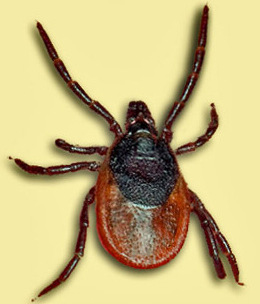Top Qs
Timeline
Chat
Perspective
Ixodes persulcatus
Species of tick From Wikipedia, the free encyclopedia
Remove ads
Ixodes persulcatus, the taiga tick, is a species of hard-bodied tick distributed from Europe through central and northern Asia to China and Japan.[1] The sexual dimorphism of the species is marked, the male being much smaller than the female.[2] Hosts include wild and domestic ungulates, man, dog, rabbit, and other small mammals, including the dormouse, Amur hedgehog, and occasionally birds.[3]
Remove ads
Disease transmission
Ixodes persulcatus ticks transmit Lyme disease, relapsing fever (Borrelia miyamotoi), babesiosis, and Siberian (TBEV-Sib) and Far Eastern (TBEV-FE) tick-borne encephalitis,[1][4] and probably human granulocytic anaplasmosis as well.[5] A recent study of the northernmost tick-borne encephalitis focus in Simo, Finnish Lapland, found I. persulcatus ticks in scattered foci along the western coast, including the Kokkola archipelago and Närpes municipality, demonstrating a northward movement of foci and an unusual combination of the TBEV-Eur strain and I. persulcatus ticks in an area with no evidence of cocirculation of tick species or TBEV subtypes.[1]
Remove ads
References
Wikiwand - on
Seamless Wikipedia browsing. On steroids.
Remove ads

